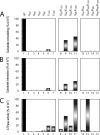Engineered interfaces of an AAA+ ATPase reveal a new nucleotide-dependent coordination mechanism
- PMID: 20197281
- PMCID: PMC2865273
- DOI: 10.1074/jbc.M110.103150
Engineered interfaces of an AAA+ ATPase reveal a new nucleotide-dependent coordination mechanism
Abstract
Homohexameric ring AAA(+) ATPases are found in all kingdoms of life and are involved in all cellular processes. To accommodate the large spectrum of substrates, the conserved AAA(+) core has become specialized through the insertion of specific substrate-binding motifs. Given their critical roles in cellular function, understanding the nucleotide-driven mechanisms of action is of wide importance. For one type of member AAA(+) protein (phage shock protein F, PspF), we identified and established the functional significance of strategically placed arginine and glutamate residues that form interacting pairs in response to nucleotide binding. We show that these interactions are critical for "cis" and "trans" subunit communication, which support coordination between subunits for nucleotide-dependent substrate remodeling. Using an allele-specific suppression approach for ATPase and substrate remodeling, we demonstrate that the targeted residues directly interact and are unlikely to make any other pairwise critical interactions. We then propose a mechanistic rationale by which the nucleotide-bound state of adjacent subunits can be sensed without direct involvement of R-finger residues. As the structural AAA(+) core is conserved, we propose that the functional networks established here could serve as a template to identify similar residue pairs in other AAA(+) proteins.
Figures






Similar articles
-
ATPase site architecture is required for self-assembly and remodeling activity of a hexameric AAA+ transcriptional activator.Mol Cell. 2012 Aug 10;47(3):484-90. doi: 10.1016/j.molcel.2012.06.012. Epub 2012 Jul 11. Mol Cell. 2012. PMID: 22789710 Free PMC article.
-
Mechanism of homotropic control to coordinate hydrolysis in a hexameric AAA+ ring ATPase.J Mol Biol. 2008 Aug 1;381(1):1-12. doi: 10.1016/j.jmb.2008.05.075. Epub 2008 Jun 5. J Mol Biol. 2008. PMID: 18599077
-
Stairway to translocation: AAA+ motor structures reveal the mechanisms of ATP-dependent substrate translocation.Protein Sci. 2020 Feb;29(2):407-419. doi: 10.1002/pro.3743. Epub 2019 Oct 17. Protein Sci. 2020. PMID: 31599052 Free PMC article. Review.
-
trans-Acting arginine residues in the AAA+ chaperone ClpB allosterically regulate the activity through inter- and intradomain communication.J Biol Chem. 2014 Nov 21;289(47):32965-76. doi: 10.1074/jbc.M114.608828. Epub 2014 Sep 24. J Biol Chem. 2014. PMID: 25253689 Free PMC article.
-
Conserved arginine residues implicated in ATP hydrolysis, nucleotide-sensing, and inter-subunit interactions in AAA and AAA+ ATPases.J Struct Biol. 2004 Apr-May;146(1-2):106-12. doi: 10.1016/j.jsb.2003.11.008. J Struct Biol. 2004. PMID: 15095758 Review.
Cited by
-
ATPase site architecture is required for self-assembly and remodeling activity of a hexameric AAA+ transcriptional activator.Mol Cell. 2012 Aug 10;47(3):484-90. doi: 10.1016/j.molcel.2012.06.012. Epub 2012 Jul 11. Mol Cell. 2012. PMID: 22789710 Free PMC article.
-
The heptameric structure of the flagellar regulatory protein FlrC is indispensable for ATPase activity and disassembled by cyclic-di-GMP.J Biol Chem. 2020 Dec 11;295(50):16960-16974. doi: 10.1074/jbc.RA120.014083. Epub 2020 Sep 30. J Biol Chem. 2020. PMID: 32998953 Free PMC article.
-
Unique ATPase site architecture triggers cis-mediated synchronized ATP binding in heptameric AAA+-ATPase domain of flagellar regulatory protein FlrC.J Biol Chem. 2015 Apr 3;290(14):8734-47. doi: 10.1074/jbc.M114.611434. Epub 2015 Feb 16. J Biol Chem. 2015. PMID: 25688103 Free PMC article.
-
Assessing heterogeneity in oligomeric AAA+ machines.Cell Mol Life Sci. 2017 Mar;74(6):1001-1018. doi: 10.1007/s00018-016-2374-z. Epub 2016 Sep 26. Cell Mol Life Sci. 2017. PMID: 27669691 Free PMC article. Review.
-
Single chain forms of the enhancer binding protein PspF provide insights into geometric requirements for gene activation.J Biol Chem. 2011 Apr 8;286(14):12734-42. doi: 10.1074/jbc.M110.203554. Epub 2011 Feb 7. J Biol Chem. 2011. PMID: 21300807 Free PMC article.
References
-
- Konakova M., Pulst S. M. (2005) J. Mol. Neurosci. 25, 105–117 - PubMed
-
- Guinto J. B., Ritson G. P., Taylor J. P., Forman M. S. (2007) Acta Neuropathol. 114, 55–61 - PubMed
-
- Kimonis V. E., Watts G. D. (2005) Alzheimer Dis. Assoc. Disord. 19, S44–S47 - PubMed
-
- Watts G. D., Mehta S. G., Zhao C., Ramdeen S., Hamilton S. J., Novack D. V., Mumm S., Whyte M. P., Mc Gillivray B., Kimonis V. E. (2005) Hum. Genet. 118, 508–514 - PubMed
-
- Watts G. D., Thomasova D., Ramdeen S. K., Fulchiero E. C., Mehta S. G., Drachman D. A., Weihl C. C., Jamrozik Z., Kwiecinski H., Kaminska A., Kimonis V. E. (2007) Clin. Genet. 72, 420–426 - PubMed
Publication types
MeSH terms
Substances
Grants and funding
LinkOut - more resources
Full Text Sources
Research Materials

